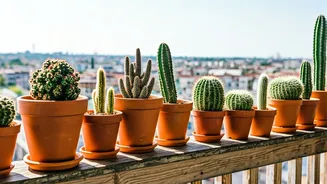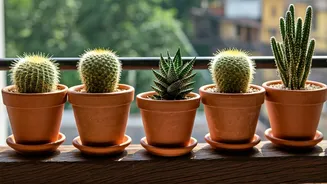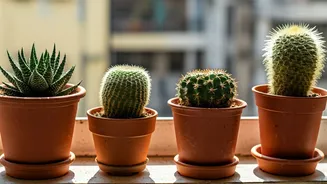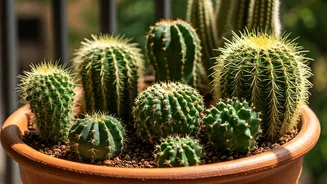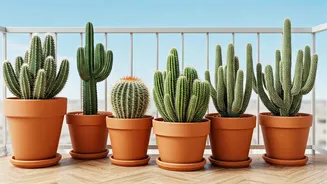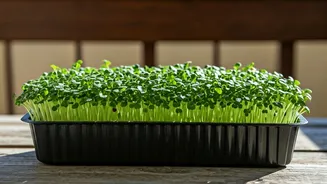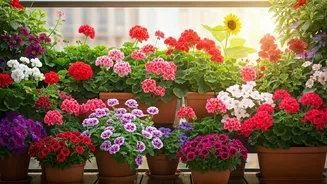Introduction: Desert Balcony
Balcony gardens offer a unique opportunity to bring nature into urban living spaces. Cacti, known for their resilience and striking beauty, are an ideal
choice for such settings. Their low-maintenance nature makes them perfect for busy individuals or those new to gardening. This article explores seven cactus varieties that thrive in balcony environments, offering guidance on selection, care, and maintenance to help you create your own desert-inspired sanctuary. The goal is to provide a comprehensive understanding of each cactus type, including their specific needs, enabling you to curate a flourishing and visually appealing green space right outside your door.
1. Saguaro's Cousins
The Saguaro cactus, a symbol of the American Southwest, is often too large for balconies, but several of its smaller relatives are perfect. Consider species like the Golden Barrel Cactus (Echinocactus grusonii). These compact cacti feature rounded, ribbed bodies and produce vibrant yellow flowers. They thrive in well-draining soil and require ample sunlight, making them ideal for balconies with good exposure. Water sparingly, allowing the soil to dry out completely between waterings. These cacti can add a touch of desert landscape to a balcony with their unique form.
2. The Prickly Pear Family
Prickly pear cacti (Opuntia) are another excellent choice, known for their flat, pad-like segments. They are relatively easy to care for and come in various sizes and shapes. The Opuntia microdasys, often called the bunny ears cactus, is particularly charming with its fuzzy, white glochids. These cacti need well-draining soil and full sun, so balconies with a sunny exposure are best. Be cautious when handling these cacti, as the glochids can detach and embed in the skin. Water moderately during the growing season and reduce watering in the winter.
3. Star-Shaped Beauty
Astrophytum, or star cacti, are highly sought after for their unique, star-shaped forms. These cacti come in various species, each with distinct characteristics. Astrophytum myriostigma (bishop’s cap) is particularly popular, featuring a spineless body with white flecks. These cacti require bright light and well-draining soil. Water sparingly, allowing the soil to dry out between waterings. Fertilize lightly during the growing season. Their striking appearance adds an artistic flair to any balcony garden, making them a focal point.
4. The Cereus Columnars
Cereus cacti, also known as night-blooming cereus, can be another great choice. Some Cereus species are column-shaped. While some Cereus can grow quite large, there are several Cereus varieties that can be maintained on a balcony. These cacti often have showy flowers that bloom at night. They prefer full sun and well-draining soil. Ensure proper support, especially if the cactus grows tall. Water moderately, allowing the soil to dry out between waterings, and reduce watering in winter. Their majestic appearance can provide vertical interest.
5. Easy-Care Mammillaria
Mammillaria is a large genus of cacti, known for their small size and ease of care. These cacti often have rounded or cylindrical shapes with nipple-like tubercles. They are excellent choices for beginners. They thrive in well-draining soil and require ample sunlight. They produce beautiful flowers, adding color to the balcony. Water sparingly and allow the soil to dry out between waterings. These cacti are perfect for small spaces and are relatively low-maintenance, making them a good option for people who want to keep cactus on their balcony.
6. The Festive Christmas Cactus
The Christmas cactus (Schlumbergera bridgesii) is a popular choice for indoor gardens and balconies. These cacti have flattened, segmented stems and produce vibrant flowers during the holiday season. They prefer bright, indirect light and well-draining soil. Water when the top inch of soil is dry, and mist the plant regularly to maintain humidity. These cacti offer a burst of color and a festive spirit, making them ideal for brightening up a balcony garden, especially during the colder months.
7. Echeveria & Sedum Mix
While not technically cacti, echeverias and sedums are succulent plants that share similar care requirements and can complement cacti in a balcony garden. Echeverias feature rosette-shaped leaves in various colors, while sedums come in many forms, some of which are trailing and perfect for hanging planters. These succulents require bright sunlight and well-draining soil. Water when the soil is completely dry, and avoid overwatering. Their diverse shapes and colors can create a visually appealing arrangement, enhancing the overall aesthetic of your balcony garden and providing a contrast to the cacti.
